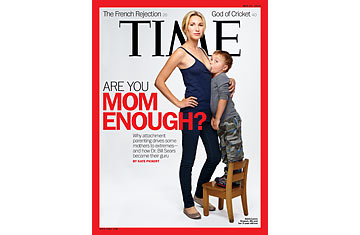
(3 of 5)
The science on attachment is also easily misunderstood and misused. The father of attachment theory is John Bowlby, a British psychoanalyst who in the mid — 20th century studied orphans and children abandoned by their mothers. The difference between children without consistent relationships with parents (or parental figures of any kind) and well-parented children who are fed formula (instead of breast milk) and put in bouncy seats (instead of slings) is huge. The former, science says, are headed for developmental and emotional problems. There's no science to show that the latter will turn out any different from children raised via the attachment-parenting methods championed by Sears. But it is easy for a mother reading Sears to confuse the two and believe she is doing irreparable harm by not holding her baby constantly and ensuring the infant never cries for more than a moment.
Sears' followers trust him as much because of his role as a father as because of the four decades he's spent in medicine. The Searses have eight children, ages 20 to 45. So much parenting has given them a wide range of experiences. They have a son with Down syndrome and an adopted daughter. Martha birthed four children in hospitals and three at home. Their first three babies were "easy"; their fourth had terrible colic. The three oldest boys are all doctors. The Searses have seen it all, the thinking goes, and they write extensively about their own parenting in their books.
In addition to their experiences at home, Sears says, "We use our practice as a laboratory," describing his advice as "what works for most parents most of the time." But Sears actually came up with his particular brand of mother-baby closeness after reading a book called The Continuum Concept, written by Jean Liedloff and published in 1975. In the early 1950s, Liedloff, born and raised in Manhattan, dropped out of Cornell University and was traveling around Europe, working as a part-time model. On an impulse, she accepted an invitation to travel to Venezuela on a diamond-plundering expedition. After seven months in the jungle, Liedloff returned to New York with about $1,000 in profits. She returned to the Venezuelan jungle four more times over 2 years.
During her travels, Liedloff watched indigenous people in the South American jungle care for their babies. She observed that the infants were carried all the time and seemed to cry less than their Western counterparts. Back in New York, Liedloff turned this observation into The Continuum Concept, writing that the jungle children (she called them "little angels") "were uniformly well-behaved: never fought, were never punished, always obeyed happily and instantly." In contrast, she wrote, Western parents will leave a baby to cry "until its heart is broken and it gives up, goes numb, and becomes a 'good baby.'"
Liedloff's general theory was that American parents had become divorced from their natural instincts, to the detriment of their babies. "We read the book and thought, Well, this is neat," says Sears. The predecessor to the blockbuster Baby Book was Sears' Creative Parenting: How to Use the New Continuum Concept to Raise Children Successfully from Birth to Adolescence, published in 1982.
Despite her deep interest in the connections between mothers and babies, Liedloff never had children. She died in 2011 on a houseboat in Sausalito, Calif., where she lived with her cat, Tulip.
Fans and critics of attachment parenting can agree on two things: there has been a sea change in American child rearing over the past 20 years, and no one has been a more enthusiastic cheerleader for it than Sears. Slings and carriers, like the kind Sears sells on his website AskDrSears.com are now on every list of must-have baby gear. Breast-feeding is more popular than at any other time since the baby-formula boom of the 1950s. And despite public-health warnings against it, in 2005, according to the CDC, 19% of 2-month-old babies slept in beds with their mothers, a phenomenon almost unheard of 20 years ago.
"So many of the ideas of attachment parenting are in the culture even if you don't believe in Dr. Sears per se," says Pamela Druckerman, author of Bringing Up Bébé, a new book on French parenting, which Druckerman says demands far less of mothers than its American counterpart. "This is a new common sense."
Parental common sense has a way of evolving, usually in a reactionary way. Dr. Benjamin Spock first published his volume Dr. Spock's Baby and Child Care in 1945, but before that, child-rearing conventional wisdom was based on the book Psychological Care of Infant and Child, written by James Watson and published in 1928. Watson's methods sound almost criminally neglectful by today's standards. He warned of "the dangers lurking in a mother's kiss," urging parents to shake their children's hands in the morning and put their children out in backyards alone inside fences. Spock pushed this aside in his book, telling parents to trust their instincts, writing, "You know more than you think you do." The same kind of reactionary behavior happens in parents themselves. The Searses promote a style of parenting that's the opposite of what they grew up with; Liedloff did too. In The Continuum Concept, she reveals that she was raised by her grandmother. "Turning to my mother always ended in my being hurt," she wrote.
